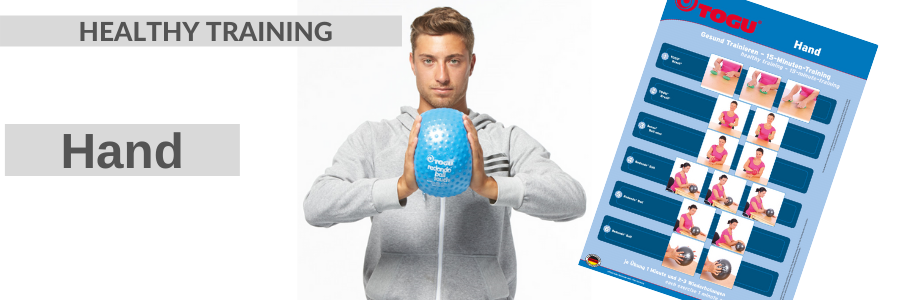Understanding the muscles of the hand
The hand as a "gripping organ" is an important part of the body with a multitude of practical functions. It consists of many individual bones and joints, e.g. the carpus alone (everyone who uses a mouse in the office every day knows it) is made up of eight different bones. Most of the muscles for hand movements are located on the forearm. In addition, the fingers in particular are equipped with many receptors that are responsible for the sense of touch.
Consequently, there are a large number of possible problems that can arise in the hand due to injury or permanent overuse.
Better mobility through hand training and holding exercises
Gripping exercises and holding exercises are excellent methods to promote mobility and strength through hand training:
Increase finger flexibility:
Grasping exercises require the repeated contraction and relaxation of the finger muscles. This helps to increase the flexibility of the fingers and improve the freedom of movement of the tendons, ligaments and joints.
Improve finger strength:
Grasping and holding resistance elements, such as balls or hand exercisers, strengthens the muscles in the fingers and palm. Strengthened muscles can promote finger mobility as they can better control and stabilise the fingers.
Increase wrist mobility:
Holding exercises where you hold objects for a long period of time help to improve wrist stability and mobility. This is particularly useful if you participate in activities that require constant wrist movement, such as playing musical instruments or working with tools.
Reduce stiffness and pain:
By doing regular gripping and holding exercises, you can increase the blood flow in your hands. This can help reduce stiffness and pain in the hands, especially for people who suffer from conditions such as arthritis.
Improve fine motor skills:
Grasping and holding exercises require precise hand movements. By performing such exercises regularly, you can improve your fine motor skills and dexterity, which manifests itself in better hand mobility.
The mobility of the hand can be promoted through simple grasping and holding exercises. The TOGU devices provide additional stimuli and train the sensorimotor system, which, to put it simply, represents the interaction between sensory (e.g. nerve pathways) and motor (e.g. muscles, tendons, ligaments) performance of the body.
Support in hand training with training devices
Hand training devices such as round or long pimple balls are specially designed tools to strengthen hand muscles, improve flexibility and enhance dexterity. These devices provide targeted training and allow you to increase hand strength and improve finger coordination and dexterity. They are also useful for rehabilitation after hand injury or surgery and can help prevent injury.
In addition, they increase blood circulation in the hands and allow for customisable intensity of training. Hand exercisers are versatile and suitable for people of all ages and fitness levels to promote hand health and performance.
Frequently asked questions about hand training
Why is it important to train hand muscles?
Training the hand muscles improves grip strength, dexterity and helps you perform daily tasks.
Which exercises are best for hand muscle training?
Gripping exercises, finger stretches and hand trainers are effective exercises for strengthening the hand muscles.
How often should I do my hand muscle training?
A few minutes of hand training most days of the week is enough to make progress.
Are hand exercisers suitable for all ages?
Yes, they are suitable for people of all ages to strengthen hand muscles and improve dexterity.
What are the benefits of hand muscle training for athletes?
Athletes benefit from better grip strength, hand-eye coordination and performance in sports activities.
How can I integrate my hand training into my daily work routine?
Use short breaks to perform simple hand exercises at your desk to activate the hand muscles.
What results can I expect from regular hand muscle training?
Regular training leads to stronger hands, improved mobility and an increased ability to perform everyday tasks.













